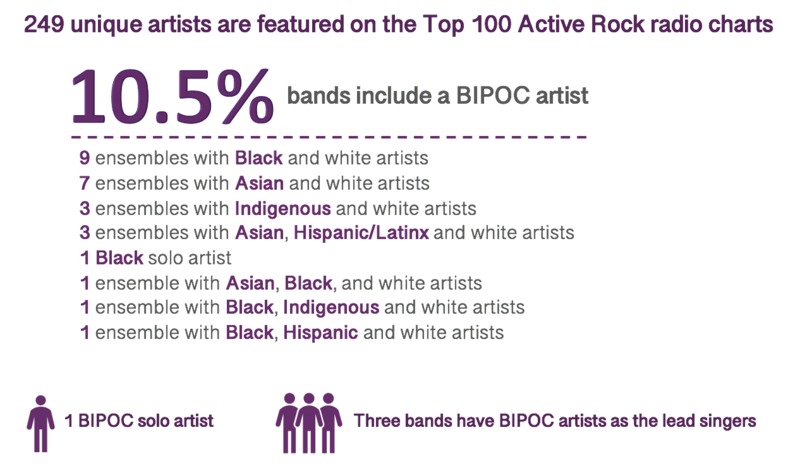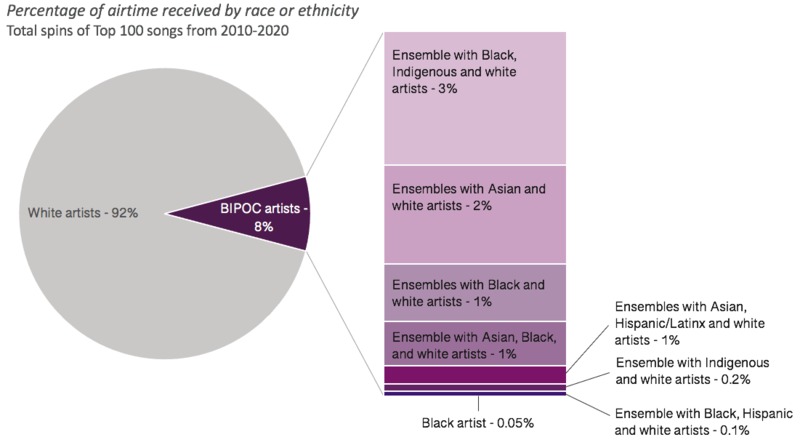Race and Ethnicity Representation
SO MANY WHITE DUDES
It is difficult to view the data in any way that is not blindingly white. Of the 1,100 charting songs, 89 songs are by Black, Indigenous or person of colour (BIPOC) artists, for a total of 0.09% of songs by a Black solo artist (Lenny Kravitz) and 8% by mixed-race ensembles. This number is small, and some of these songs are duplicated because they charted for multiple years. Further, there were 249 unique artists featured on the Top 100 active rock radio charts, and only 26 include a BIPOC artist. This equates to 10.5% of the bands, yet these ensembles only account for 8% of charting songs. However, some bands are skewing the data, because one ensemble that is composed of Black, Indigenous and white artists (Foo Fighters) accounts for almost 27% of songs by BIPOC artists. If we were to remove the Foo Fighters, who account for 3% of all airtime, the remaining 5% of airtime given to BIPOC artists is split between 25 bands. For example, there are nine bands composed of Black and white artists, but they only account for 1% of total spins and 1.7% of charting songs. It is also worth noting that other than Lenny Kravitz, all artists in the dataset are white or have white member(s) in their ensemble. BIPOC artists may be included in the top charting active rock bands, however their songs are played less frequently.
There is more racial and ethnic diversity than gender diversity in active rock. While 10.5% of bands with a BIPOC artist is not a large number, compared to the representation of women or 2SLGBQ+ artists, the figure stands out as significant. The data indicates that women and 2SLGBQ+ artists face additional barriers to success in the active rock industry than BIPOC men. Three bands have BIPOC artists as lead vocalists, of which two are members of the 2SLGBQ+ community. Nearly 20% of BIPOC bands include a woman, which is double the percentage of women (10%) in all charting bands.
As was done in the graphs for 2SLGBQ+ Representation, artists that were assumed white and confirmed white are represented as white. In many cases, race, unlike sexuality, cannot be hidden. However, if an artist was not vocal about their racial or ethnic heritage, and if it was not included in a biography, then we assumed whiteness.
The final graph shown below outlines the distribution of BIPOC artists within the top 10 songs annually. When compared to a similar graph looking at gender, we can see that there are BIPOC ensembles that reached the top 10 spots in the charts, however these ensembles are composed exclusively of men. If we only look at the small portion of marginalized artists, it is clear that the diversity within these ensembles contrasts drastically to the active rock radio format as a whole, but this diversity does not extend to include the top 10 ranked songs.
Featured Artist
Lenny Kravitz is a legendary American artist that has shaped the music industry, outside of just rock. He is the only Black solo artist in the dataset, and peaked in the 2011 charts at 71 with his song "Come On Get It". The Grammy-winning Kravitz has released 11 studio albums, falling with a range of genres from funk to soul to rock. A versatile musician, he plays most if not all instruments on every track of his records since his first release in 1992 (Aledort, 2008). Kravitz is also well known as a fashion icon, and for his roles acting in various movies.




